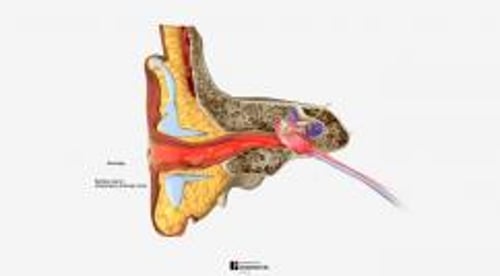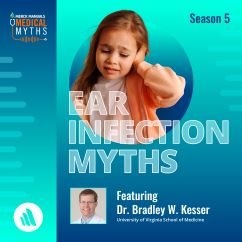Bacteria and sometimes fungi can cause acute infection of the skin of the ear canal.
Topic Resources
Ear canal infection is caused by bacteria or, less commonly, fungi.
Typical symptoms are pain and discharge.
A doctor looks in the ear with an otoscope for redness, swelling, and pus.
Doctors remove debris, prescribe antibiotic ear drops, instruct people to keep water and cotton swabs out of the ear, and recommend or prescribe pain relievers.
Infection may involve the entire ear canal, as in generalized or acute external otitis, or just one small area, as when pus accumulates in a boil (furuncle) or pimple. Malignant external otitis is a rare, very severe external ear infection that has spread to the temporal bone of the skull, causing a bone infection (osteomyelitis).
Causes of Ear Canal Infection
A variety of bacteria, such as Pseudomonas aeruginosa or Staphylococcus aureus, can infect the ear canal. Fungal ear canal infection (otomycosis), typically caused by Aspergillus niger or Candida albicans, is less common. Boils are usually caused by Staphylococcus aureus.
Certain people, including those who have allergies, psoriasis, eczema, or seborrheic dermatitis, are particularly prone to acute external otitis.
Common risk factors for ear canal infection include
Use of cotton swabs
Injuring the ear canal while cleaning it
Getting water in the ear, particularly while swimming (called swimmer's ear)
Use of earplugs or hearing aids (particularly if these devices are not adequately cleaned or do not fit correctly)
Getting irritants such as hair spray or hair dye in the ear
Use of cotton swabs to clean the ear is a very common risk factor for ear canal infection. Cotton swabs should not be placed in the ear canal.
Symptoms of Ear Canal Infection
Symptoms of acute external otitis include pain, redness, and discharge. The discharge is unpleasant-smelling and white or yellow and drains from the ear. The ear canal may not swell or swell only slightly. In severe cases, it may be swollen completely closed. If the ear canal swells or fills with pus and debris, hearing is impaired. Usually, the canal is tender and hurts if the external ear (pinna) is pulled or tugged, or if pressure is placed on the fold of skin and cartilage in front of the ear canal (tragus).
If the ear canal infection is fungal, people are more likely to have intense itching than pain. They also have a feeling of fullness in the ear. Fungal infection caused by Aspergillus niger usually causes grayish black or yellow dots surrounded by a cottonlike material to form in the ear canal. Fungal infection caused by Candida albicans does not cause any visible fungi to form but usually causes a thick, creamy white discharge.
Boils cause severe pain. When they rupture, a small amount of blood and pus may leak from the ear.
Diagnosis of Ear Canal Infection
A doctor's examination of the ear canal
Sometimes culture of a sample from the ear canal
The doctor bases the diagnosis of ear canal infection on symptoms and an examination of the ear canal. To a doctor looking into the ear canal through an otoscope (a device for viewing the canal and eardrum), the skin of the canal appears red and swollen and may be littered with pus and debris. An infection caused by a fungus is diagnosed based on examination or results of culture (a sample of the pus and debris is grown in a laboratory to identify the microorganisms). Sometimes fungal spores can be seen in the ear canal.
Treatment of Ear Canal Infection
Removal of infected debris from the ear canal and precautions to keep the ear dry
Ear drops containing white vinegar and/or corticosteroids
Sometimes ear drops that contain antibiotics
Rarely antibiotics taken by mouth
To treat ear canal infection due to any cause, a doctor first removes the infected debris from the canal with suction or dry cotton swabs. After the ear canal is cleaned, hearing often returns to normal.
Usually, a person with a mild ear canal infection is given ear drops that contain white vinegar and drops that contain a corticosteroid (such as hydrocortisone or dexamethasone) to use several times a day for up to a week. White vinegar (acetic acid) is helpful because bacteria do not grow as well in an acidic environment. Usually, a person with a mild ear canal infection is given ear drops that contain white vinegar and drops that contain a corticosteroid (such as hydrocortisone or dexamethasone) to use several times a day for up to a week. White vinegar (acetic acid) is helpful because bacteria do not grow as well in an acidic environment.
With moderate or severe infection, antibiotic ear drops also are prescribed. If the ear canal is very swollen, a doctor inserts a small wick into the ear canal to allow the antibiotic/corticosteroid ear drops to penetrate. The wick is left in place for 24 to 72 hours. After this time, the swelling may have gone down enough to allow the drops to go directly into the ear canal.
People who have severe acute external otitis (infection that extends beyond the ear canal) may need to take antibiotics (such as cephalexin or ciprofloxacin) by mouth.People who have severe acute external otitis (infection that extends beyond the ear canal) may need to take antibiotics (such as cephalexin or ciprofloxacin) by mouth.
Pain relievers such as acetaminophen or ibuprofen may help reduce pain for the first 24 to 48 hours, until the inflammation begins to subside.Pain relievers such as acetaminophen or ibuprofen may help reduce pain for the first 24 to 48 hours, until the inflammation begins to subside.
To treat fungal ear canal infection, doctors thoroughly clean the ear canal and insert antifungal ear drops. Repeated cleanings and treatments may be needed. Some doctors believe that a combination of rubbing alcohol and white vinegar is particularly effective for fungal ear canal infections. Rubbing alcohol dries the ear canal and white vinegar creates an acidic environment that does not allow fungus to grow as well.
For both bacterial and fungal infection, people should keep the ear dry by practicing dry ear precautions (such as wearing a shower cap and avoiding swimming) until the infection clears up. A blow dryer on a low setting can also be used to reduce the humidity and moisture in the canal.
For boils, a heating pad can be applied for a short time and pain relievers can be given to help relieve pain. The heat may also help speed healing. An antibiotic is given by mouth. A boil that has come to a head is cut open (incised) to drain the pus.
Prevention of Ear Canal Infection
Swimmer's ear may be prevented by putting drops of a solution containing half rubbing alcohol and half white vinegar (acetic acid) in the ear immediately after swimming. This treatment should be done only if the eardrum is intact (that is, has no holes in it). The alcohol helps the water evaporate, and the vinegar alters the acidity of the canal.may be prevented by putting drops of a solution containing half rubbing alcohol and half white vinegar (acetic acid) in the ear immediately after swimming. This treatment should be done only if the eardrum is intact (that is, has no holes in it). The alcohol helps the water evaporate, and the vinegar alters the acidity of the canal.
Attempting to clean the canal with cotton swabs or other objects is strongly discouraged because such action interrupts the ear's normal, self-cleaning mechanism and can push debris and earwax further inward. Also, this action may cause minor damage to the delicate skin of the canal, providing a site for bacteria to infect.



